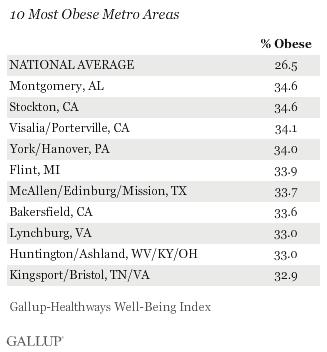Although California is often admired for its healthy living, three of it’s cities made it to the 10 Most Obese Metro Areas list. Stockton, CA—which was also recently crowned Most Miserable US City by Forbes—has the highest obesity rate, with 34.6 percent of residents being overweight. This compares to a national average of 26.5 percent obesity, up from 25.5 percent in 2008.

Results from the Gallup poll show that regions ranking high on obesity generally rank low on healthy behavior indicators. Specifically, all of the 10 most obese metro areas (shown above) fall within the bottom two-thirds of all areas surveyed for frequent exercise. Furthermore, when they asked if people had a safe place to exercise, six of the areas came in below the national average.
In terms of eating habits, “of the 10 most obese places, seven are in the bottom two-thirds among all metro areas for reporting eating healthy “yesterday” and for fruit and vegetable consumption.” We know that eating habits develop based on food access and affordability, as well as nutrition education.
“Everyone has a role to play in this fight: the private sector, the public sector and parents must unite to combat the challenge,” said Lisa Gable, Executive Director of the The Healthy Weight Commitment Foundation . In fact, the group just launched a $20 million anti-obesity campaign to encourage some of the world’s largest food makers (including Pepsi, General Mills, and Nestle) to reconsider the way they sell their products. This includes encouraging food companies to make packaging and labeling easier for consumers to manage their calorie intake while preserving or enhancing overall nutrition quality.
Are you enjoying this article? Read more like this, plus SSIR's full archive of content, when you subscribe.
Interestingly enough, The Healthy Weight Commitment Foundation is a partnership between these very organizations they seek to influence. More than 60 of the nation’s largest retailers, non-profit organizations, food and beverage manufacturers and trade associations are behind this effort to reduce obesity, especially childhood obesity, by 2015.
Because obesity is linked to chronic health problems like high blood pressure, diabetes, and heart attack, it becomes an economic problem, too. Lack of access to health insurance only exacerbates the problem, leaving people sick and public services stretched. (A few months ago, the New York Times shared two graphs showing national obesity rates and Medicare expenditures).
Gable describes their program to target the fitness and nutrition aspects of the problem: “We are supporting physical and nutrition education in schools, promoting workplace wellness within our organizations, and making more healthy foods and beverages available to consumers in the marketplace.”
She continues, “Obesity is a serious health and economic issue for our country, one we all must work together to solve.”
Support SSIR’s coverage of cross-sector solutions to global challenges.
Help us further the reach of innovative ideas. Donate today.
Read more stories by Halle Tecco.

